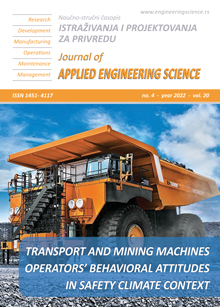LEAD TIME PREDICTION FOR SHEETER MACHINE PRODUCTION IN A PAPER CONVERSION INDUSTRY
Abstract
Lead time is a critical performance measure in any manufacturing setting Key Performance Indicator (KPI). The same is true in the paper conversion industry, which has a significant degree of product variability. Due to the great variety of their products, all industries must be able to foresee and plan ahead in order to meet client demand. With contemporary research concentrating on machine learning and simulation techniques, businesses must implement a manufacturing execution system (MES) to track data. However, without such a framework, applying machine learning and simulation approaches becomes difficult. This study introduces a novel method for forecasting lead time (special to sheeter machines used in the paper conversion sector) by combining the time required to process the reel (sheeting time) with the human (setup) elements. The method used to calculate the sheeting time takes product parameters into account, allowing for product-specific lead time forecast. As a result, a very successful 'product-specific' lead time prediction approach for small scale enterprises has been developed that enables production planning without relying on current and data-intensive prediction methods such as machine learning and simulation.
References
Dey, S., Sharma, R. R. K., and Pandey, B. K. (2019). Relationship of Manufacturing Flexibility with Organizational Strategy. Global Journal of Flexible Systems Management, vol. 20, no. 3, pp. 237–256, DOI: 10.1007/s40171-019-00212-x.
Gyulai, D., Pfeiffer, A., Nick, G., Gallina, V., Sihn, W., & Monostori, L. (2018). Lead time prediction in a flow-shop environment with analytical and machine learning approaches. IFAC-PapersOnLine, vol. 51, no. 11, pp. 1029–1034, DOI: 10.1016/j.ifacol.2018.08.472.
Zhu, H., and Woo, J. H. (2021). Hybrid NHPSO-JTVAC-SVM Model to Predict Production Lead Time. Applied Sciences, vol. 11, no. 14, p. 6369, DOI: 10.3390/app11146369.
4. Gherghea, I. C., Bungau, C., and Negrau, D. C. (2019, August). Lead time reduction and increasing productivity by implementing lean manufacturing methods in cnc processing center. In IOP Conference Series: Materials Science and Engineering, 2019, vol. 568, no. 1, p. 012014, DOI: 10.1088/1757-899X/568/1/012014.
Lang, S., Behrendt, F., Lanzerath, N., Reggelin, T., and Müller, M. (2020, December). Integration of deep reinforcement learning and discrete-event simulation for real-time scheduling of a flexible job shop production. Winter Simulation Conference (WSC), 2020, pp. 3057–3068. DOI: 10.1109/WSC48552.2020.9383997.
Yuan, Z., Qiao, Y., Guo, Y., Wang, Y., Chen, C., and Wang, W. (2020). Research on lean planning and optimization for precast component production based on discrete event simulation. Advances in Civil Engineering, vol. 2020, pp. 1–14, Nov. DOI: 10.1155/2020/8814914.
Qiao, D., and Wang, Y. (2021, March). A review of the application of discrete event simulation in manufacturing. In Journal of Physics: Conference Series, 2021, vol. 1802, no. 2, p. 022066, DOI: 10.1088/1742-6596/1802/2/022066.
Solomon, H., Jilcha, K., and Berhan, E. (2015). Lead time prediction using simulation in leather shoe manufacturing. In Afro-European Conference for Industrial Advancement, 2015, pp. 283–292. DOI: 10.1007/978-3-319-13572-4_23.
Singh, S., and Soni, U. (2019, January). Predicting order lead time for just in time production system using various machine learning algorithms: A case study. In 2019 9th International Conference on Cloud Computing, Data Science & Engineering, 2019, pp. 422–425. DOI: 10.1109/CONFLUENCE.2019.8776892.
Bethea, R. M. (2018). Statistical methods for engineers and scientists. CRC Press, DOI: 10.1201/9780203738580.
Beyer, W. H. (2019). Handbook of tables for probability and statistics. CRC Press, DOI: 10.1201/9781351073127

